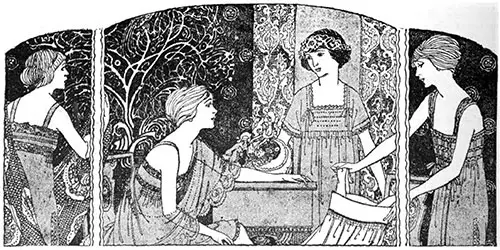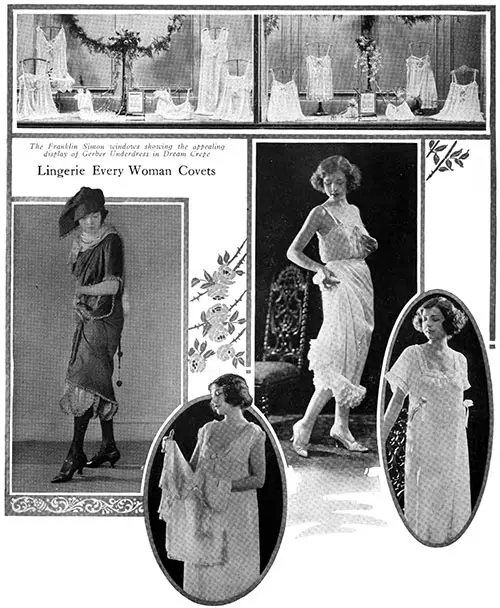Novelties Abound in Exotic Lingerie Showing 1921

A superb robe d'intime of a splendor which allows it to serve as hostess gown was recently shown composed of supple cloth of gold shot with mauve. The under slip was a complete departure in the matter of lines from those of recent seasons. A softly folded surplice section above was stitched to the straight-line lower sections so that it composed a princess foundation.
Draped from the shoulders was a long robe of gold and jade brocade chiffon a part of the section from shoulders and sleeves reaching in jacket-like lines to the elbows.
A collection of crepe robes was opened which defined an exceptionally artistic informal receiving gown and one for the convalescent which makes it ideal for the chaise longue.
This latter model showed a softly bloused upper section below which was a wide sash-girdle while the fronts dropped to the ankles in two long double or draped panels.
This means that no fabric was used below the waist at the back and that for wear over a robe de nuit, or chemise, it struck a new note of comfort for the invalid or for idle hours in the privacy of one's room.
The first of the collection mentioned was in the heavy lustrous Oriental crepe now so admired and showed a silhouette precisely like that of the beetle or mummy wrap.
The closing line was affected by a cluster of exquisite silk flowers, while from the shoulders a broad panel of chiffon dropped down the back to the lower edge. From within the dolman-like sleeves came a wide picot-edge inner sleeve of chiffon, visible three inches below the crepe section.
Complete outer robes of net, chiffon, all-over lace, and embroidered georgette may now be found ready to adjust to foundations.
Exotic Lingerie Marks the New Season

The lingerie displays of January were marked by two highly contrasted types of creative design. There were, at the smartest specialty shops, lavish exhibitions which stressed exotic color or novel treatment as their strong points of attraction.
On the other hand, there were the White Sales displays of exquisite handmade lingerie where every needle stroke bespoke the work of fairy fingers.
In the group of coloresque effective ness a window showing at Bonwit Teller's exceeded in novel details and extravagance of color and line anything displayed for months.
No house in the country pays more significant attention to this department. It may, therefore, be said to inaugurate movements in far-reaching fashion.
The use of high color was noticeable in a set of purple-blue chiffon with pale jade and sapphire blue bands introduced to emphasize the medieval waistline.
The effort to keep an unbroken line beneath the crepes and other supple fabrics adopted for Spring marks a new lingerie adaptation to outer dress requirements.
In the handling of the princess slips for wear with the again popularized petal dresses, this house presents an exquisite feature in a rainbow novelty.
Net and chiffon exploited the pointed panel, the fluttering sections of which were many in number and picot-edged array of overlapping tones of yellow, pale jade, flame, mauve and pale turquoise.
Dozens of these narrow-pointed petal-panels were caught at the waistline of a smoothly fitted waist section, entirely unornamented, and cut camisole fashion with a narrow strap of self-fabric.
For wear under sheer lace frocks or the robe d'intereur, these charming novelties offer grace and beauty to an unusual degree.
The Franklin Simon Novelty

At Franklin Simon's during a week of window exploitation of grey Southern Resorts wear, the corner windows contained striking novelties in lingerie in grey crepe de chine.
The decorative background adopted for this unusual display was of such a character as to command prolonged scrutiny and is described in full under the caption, "The Poster Exotic," below.
The merchandise included the full lingerie line and showed the tiny French mannequin with exact duplicates of several features—the combinations, pajamas, chemise, robe de nuit, etc.
The models were entirely plain of cut but introduced at the upper line a thick latticework of self-fabric in tiny milliner's folds caught at the crossing points by stitches of mauve floss.
Mauve satin ribbons were used, and mauve embroidery stitchery was applied to the hemlines. The design was extraordinarily appealing to the passer-by, crowding the pavements three and four deep.
Doubtless, the novelty of grey as a lingerie shade so wholly worked out will serve in one stride to establish this deluxe feature as one not to be passed over lightly.
Boudoir sets of georgette are generally inclined to pleated inset sections attached to a relatively smooth upper section. The silhouette is divided between the short Empire waist and the medieval line.
When of the Empire persuasion, the upper section is outlined by piping of one or more colors. A lovely green georgette set is, as an illustration, piped with periwinkle blue and faint coral pussy willow taffeta.
These tones are carried over the shoulders and are also employed in a group of flat futurist fruits.
The medieval line obtains a fresh and novel air through its adoption into the lingerie realm. Upon the long, straight upper section picot edge bands, one inch wide, followed the length from shoulder to hip turning to form a panel effect by rectangular lines. The lower section was fulled on and at its hemline was finished in points, picot-edged.
Black Chantilly and chiffon lingerie are continued, is the ally of the all black day and evening gowns so highly favored. Black Chantilly upon flesh satin corsets and black embroideries of striking design upon white and flesh satin are still noted in exclusive shops as features of the corset departments.
Linen Batistes and Georgettes
In the cobwebby linen, batistes were shown many beautiful examples of the alternating block set in by drawn work, by hem stitchery and by embroidery stitches or French knots. The Carrickmacross motifs were also seen in this group, and the point de Torque was conspicuous.
A striking use of the briar stitch is again employed for circles overlapping and two inches in diameter. Three are shown at the base of a shallow yoke, below entre deux of Val, Cluny, or filet laces. This stitchery in heavy linen thread was employed at the hemline, armhole, yoke, and seam finish.
The Poster Exotic
During the January window displays worked out in one color, a form of publicity adopted by Franklin Simon's, Lord and Taylor's and McCreery's, the showing of grey lingerie by Franklin Simon took on an interest apart from mere merchandise display. In fact, the unique background achieved a success meriting its continuation for a second grey showing.
The revival of a poster art introducing the life-sized figure in applique by way of silk in realistic colorings, for the face, neck, and arms showed a boudoir robe so applied in relief that its folds hung au naturel. The panel presented a beautifully handled blending of background and foreground colorings.
Other garments were draped across a low chair in the foreground while an ornate birdcage was shown on its high stand, completing a unique keenly decorative composition relinquished throughout the month. Cora Scovil signed the poster.
Another example was shown in the window of Bergdorf-Goodman of the figure of Mitzi in the picturesque dress of the Countess of Paradova, the charming title role in the musical romance "Lady Billy." The figure was of life-size against a cloth of gold background, with "Mitzi" in conspicuous letters across the top of the panel.
“The Robe D'intereur Clings to Crepes as Do the Lingerie Novelties: Novelties Abound in Exotic Lingerie Showing” and “The Observer: Impressionistic Sketches of Metropolitan Activities - The Poster Exotic“ in The American Cloak an Suit Review: Devoted to the Women's and Children's Ready-to-Wear Trades, New York: John M. O'Connor & Co., Vol. XXI, No. 2, February 1921, p. 173-174
Note: We have edited this text to correct grammatical errors and improve word choice to clarify the article for today’s readers. Changes made are typically minor, and we often left passive text “as is.” Those who need to quote the article directly should verify any changes by reviewing the original material.

